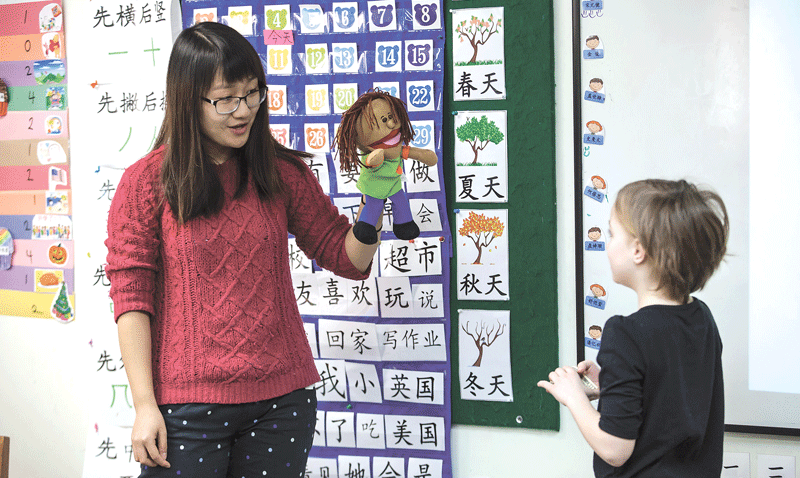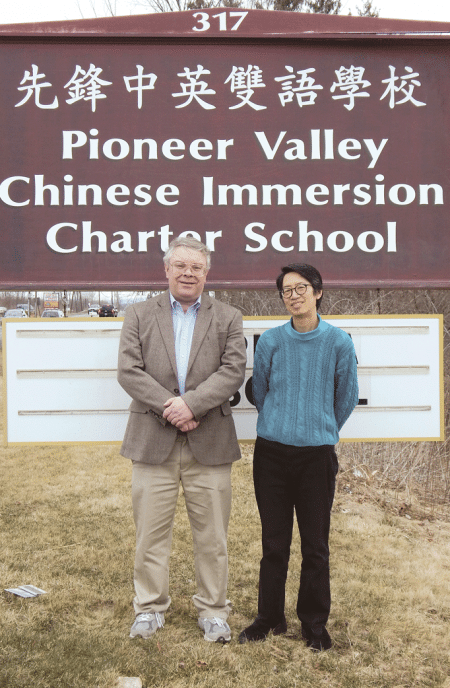Chinese Immersion Charter School Continues Growth Pattern
The Language of Business

At the Pioneer Valley Chinese Immersion Charter School, puppets and other props help young students master the Chinese language.
Richard Alcorn has not forgotten the frustration he felt when he owned a business that imported goods from China and had to communicate with non-English-speaking customers on the other side of the globe.
“There were times when I spent 45 minutes or an hour with an interpreter only to realize they had absolutely no idea what I was talking about,” he told BusinessWest.
That experience, combined with the fact that Alcorn’s wife, Kathleen Wang, wanted their children and others to be prepared to work in a changing, global economy, led the couple to establish Pioneer Valley Chinese Immersion Charter School (PVCICS) in Hadley. It was important to them because both Alcorn and Wang were involved in the Massachusetts Initiative for International Studies, a statewide initiative to instill more international focus into K-12 education.
The school opened its doors in 2007 to kindergartners and first-graders, and today boasts roughly 440 students from 39 communities in kindergarten through grade 11. The continued expansion led the couple to outgrow their space, and last year the school was enlarged with a 40,000-square-foot addition.
Next year, PVCICS will add grade 12, and the first class that will matriculate will receive international baccalaureate diplomas that will open the door to continuing-education opportunities in other countries, while providing students with skills needed to work for Chinese employers or companies that do business in that country.
Through dedication and hard work, Alcorn, Wang, and others who are passionate about their mission have established a new model for education: PVCICS is the first fully articulated K-12 Chinese-language and cultural-immersion public charter school in the country.
“In addition to learning the language, our students learn about cultural differences,” said Wang, the school’s principal, as she explained that small things make a difference; for example, in China, the proper way to hand someone a business card is with two hands, rather than one.
Knowledge of such customs is important to engender respect and good relationships while communicating with Chinese customers, suppliers, and business owners.
“The State Department has deemed Chinese as a language critical to the future of the country’s economic and national security,” Wang said, noting that more employers are looking for people proficient in this language and the country’s cultural norms.
Tricia Canavan, president of United Personnel, a temporary and full-time staffing agency in Springfield, agreed.
“We’re starting to see a demand for employees who speak Mandarin Chinese, and we are recruiting them for jobs,” she said. “It speaks to the global nature of commerce; China is the world’s second-largest economy, and there is a need for fluency in the language.”
Alcorn, executive director of PVCICS, pointed to Chinese-owned CRRC USA Rail Corp., which broke ground in September on a new, $95 million subway-car factory in Springfield, as an example of the presence Chinese companies are establishing in the U.S.

Richard Alcorn and Kathleen Wang, founders of the Pioneer Valley Chinese Immersion Charter School.
“From the time we started this school, it was clear to us that, if local companies want to conduct business with China and local communities want to encourage Chinese companies to make local investments, we need people who know the language,” he told BusinessWest.
“Massachusetts, like all of New England, is trailing the nation in developing language and cultural-immersion programs that offer students the opportunity to develop skills needed to compete globally,” he went on. “When we first opened, there were only 15 Chinese-immersion programs in the U.S., and now there are over 150 public-school programs like this.”
The vast majority of the student body at PVCICS knew no Chinese when they entered, which reflects the growing movement to make students who speak English at home bilingual.
New York City has about 180 dual-language programs where students are learning Arabic, Chinese, French, Haitian-Creole, Hebrew, Korean, Polish, Russian, and Spanish. Delaware and North Carolina have joined their ranks, while 9% of public elementary-school students in Utah are enrolled in dual-language programs, and one in every five kindergartners in Portland, Ore. are in a dual-language program.
“These programs are economic-development initiatives,” said Alcorn. “People in the workforce who are employed in global businesses really need to be bilingual.”
Rapid Growth
PVCICS opened in 2007 with 42 students. Classes were held in a strip mall in South Amherst, and as the student body grew and grade levels were added, the school moved into a 26,000-square-foot former health club in Hadley. The space was completely renovated, and last year the building underwent that 40,000-square-foot expansion to keep pace with the growing number of students.
Growth continues, and demand for seats in this free public charter school is high. Students are chosen by lottery, and more than 100 applications pour in every year for 44 kindergarten slots.
Students can also enter in sixth or ninth grades, and those who do start in introductory Mandarin Chinese, while those who entered in elementary school are in a higher-level Mandarin class.
In grades kindergarten and grade 1, 75% of daily instruction is in Chinese, and 25% is in English. In grades 2 through 5, 50% of instruction is in Chinese, and 50% is in English. As the need for an expanded vocabulary and skills in English grow, the time spent in Chinese classes is decreased. Starting in sixth grade, 25% of daily instruction is in Chinese, and 75% is in English.
Research shows that early immersion in a foreign-language program makes it easier to become fluent. Mandarin Chinese can be especially difficult for adults to learn because the language is tonal and doesn’t have an alphabet.
And PVCICS ninth-graders are proud of their language skills.
Talia O’Shea entered the school in first grade and didn’t really understand what her teachers were saying until the middle of the school year, despite the use of drawings, puppets, and other props. But by the middle of second grade, she was speaking in Chinese.
Today, she does math in the language because she learned it initially in Chinese and says she sometimes finds herself thinking in the language, rather than in her native English.
But she regards the ability to do so as a bonus.

Ninth graders Talia O’Shea, Gabe Crivelli, and Amanda Doe enjoy learning subject matter in two languages.
“China is a very significant nation in terms of politics and economics on the world stage, so being fluent in both English and Chinese will be a benefit when I get a job,” the 14-year-old told BusinessWest, adding that her proficiency could help prepare her for a government career or allow her to work as a translator.
Amanda Dee also entered PVCICS in first grade, and although she had heard Chinese spoken at home, the language really didn’t take hold until she began conversing with her peers and interacting at school.
“When you learn to speak Chinese at a really young age, it gives you a deeper understanding of the language,” she said.
Ninth-grader Gabe Crivelli entered the charter school in sixth grade because he was seeking a challenging course of academics. He found it at PVCICS, and said the combination of rigorous standards and the challenge of learning a new language exceeded his expectations. He is glad he changed schools, and believes his bilingual skills will help him in the future since he hopes to own a business.
“Students in almost every other country learn a foreign language,” he noted, adding that his sister is also a student at the school, and they sometimes speak Chinese at home.
Parents also tout the school’s benefits. Canavan said she and her husband chose to send two of their sons to PVCICS and are happy they did.
“We felt it was important for our children to be fluent in another language so they could become global citizens,” she said, adding that they were also attracted by the focus on academic rigor and character building.
Ongoing Efforts
Alcorn and Wang tried to get a Chinese-immersion school program started in Amherst before they applied to the state to start a charter school in Hadley. And although their proposal was rejected, today they are happy with the outcome.
PVCICS has been highly successful and was a recipient of the 2015 Confucius Classrooms of the Year Award, which was presented to 10 schools across the world for excellence in teaching and learning, curriculum, cultural richness, community engagement, and extracurricular activities. Only three schools in the U.S. received the award, which Alcorn accepted from the Confucius Institute at its World Conference in Shanghai. In addition, last year its students received some of the highest MCAS scores in the Commonwealth.
Parental demand for the school’s program has fueled its continued expansion. Interest in Chinese has grown, and the school has enjoyed the support of the U.S. Department of Education and the U.S. Department of Agriculture, Rural Development.
In short, this couple’s vision is yielding positive results as PVCICS helps to establish a pipeline of students whose fluency in Mandarin Chinese will enhance the local economy and give them the skills needed to flourish in a fast-changing world.





